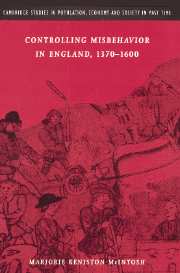Book contents
- Frontmatter
- Contents
- 1 List of illustrations
- 2 List of tables and lists
- Acknowledgements
- List of abbreviations
- Introduction
- Part I The history of social regulation
- Part II Factors that influenced social regulation
- 5 Some political considerations
- 6 Social ecology I: “broad response” and “no response” communities
- 7 Social ecology II: analysis by type of offences reported
- 8 Ideological/religious influences
- Conclusion: social regulation and the transition from medieval to early modern England
- Appendices
- Bibliography
- Index
- Cambridge Studies in Population, Economy and Society in Past Time
7 - Social ecology II: analysis by type of offences reported
Published online by Cambridge University Press: 23 November 2009
- Frontmatter
- Contents
- 1 List of illustrations
- 2 List of tables and lists
- Acknowledgements
- List of abbreviations
- Introduction
- Part I The history of social regulation
- Part II Factors that influenced social regulation
- 5 Some political considerations
- 6 Social ecology I: “broad response” and “no response” communities
- 7 Social ecology II: analysis by type of offences reported
- 8 Ideological/religious influences
- Conclusion: social regulation and the transition from medieval to early modern England
- Appendices
- Bibliography
- Index
- Cambridge Studies in Population, Economy and Society in Past Time
Summary
The geographic, demographic, and economic characteristics of the 255 smaller communities may also be examined when the places are grouped on the basis of the particular types of offences they reported over time. Variations between these groupings during the fifteenth century suggest that prior to around 1500 the “social ecology” of a community exerted some influence upon the particular forms of wrongdoing it encountered or that its leaders decided to report to their courts. In the early sixteenth century, however, the differences between groupings are blurred, so explanations are harder to propose. At the end of Elizabeth's reign we can again identify some distinctive characteristics of the communities that reported the various offences, most importantly evidence of a high and probably rising proportion of needy residents among those that mentioned problems associated with poverty. Since the data reveal fewer definite patterns than were visible in the previous chapter when comparing the “broad response” and “no response” communities, the explanations offered here should be regarded as more tentative, constituting possibilities to be explored in detailed local studies.
Method and evidence
Although our approach will in many respects be similar to that employed in Chapter 6, a strategy had to be devised for coping with the greater complexity of the data when they are subdivided by the type of offences reported. In theory one might trace the geographic, demographic, and economic characteristics of each subset of communities during each of the eleven duodecades examined here. An illustration of this exercise is given in Appendix 7.1a–i, graphs that show how the type of community varied chronologically among those places that reported each of the nine combined offences.
- Type
- Chapter
- Information
- Controlling Misbehavior in England, 1370–1600 , pp. 170 - 185Publisher: Cambridge University PressPrint publication year: 1998



